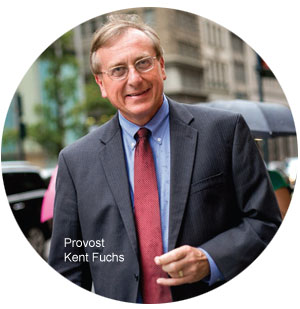
University Photography
In the eleventh century, scholars gathered in Bologna, Italy, to form the first educational institution to call itself a university. “Students from all over Europe came to Bologna, and by the middle of the twelfth century students are said to have numbered nearly 10,000,” wrote President Emeritus Frank Rhodes in his book The Creation of the Future. “The ancient university had no campus; it owned no buildings. It was a loose community of professors and students . . . with the professors often teaching in their own apartments, paid by the students lecture by lecture for their services. It was 500 years before the University of Bologna had its own buildings. So Bologna, like other older universities, was—to use modern jargon—a virtual learning community.”
As the university developed, it became a place—a residential campus where professors and students lived and worked together to engage in the business of learning. For centuries, that’s how we have thought of the university. But in the past few years, an educational revolution has begun to take shape that has the potential to alter this sense of a university as a place, perhaps to return it more to its antecedents.
While the use of computers as learning tools is well established, the advent of massive open online courses (MOOCs) is something new. Often taught by leading authorities, these courses can reach thousands of students around the world and allow them to view lectures, carry out projects, and interact with the professor and each other in a social learning environment. They are an extension of the “any person” concept that Ezra Cornell could not have imagined. They are “open”—that is, anyone can take them and they’re free. They can stand alone or be incorporated with on-campus work in blended courses. They promise to make higher education attainable—and affordable—for large numbers of students who might otherwise be excluded. They have great potential but are not without problems; many concerns have already been raised about their impact on higher education and the nature of the university.
Cornell began an in-depth evaluation of its possible role as a MOOC provider last year, when Provost Kent Fuchs, spurred by faculty interest, formed an advisory committee chaired by Eva Tardos, the Jacob Gould Schurman Professor of Computer Science. In its report, the committee stated: “Online courses are in the process of transforming education. We believe that Cornell and its faculty should be a leader in this transformation. . . . Online learning will result in data about how students learn, and contribute to Cornell’s scholarship related to teaching and learning. Understanding such data has the potential to lead to significant improvements in pedagogy and learning outcomes.”

University Photography
The advisory committee recommended that Cornell should join one of the MOOC consortia that have sprung up in recent years, concluding that “we cannot do this alone.” They narrowed the choice to two leading contenders: Coursera, a for-profit company that was already working with more than thirty universities, and edX, a nonprofit launched by Harvard and MIT that features an open-source platform. The report outlined pluses and minuses of membership in each consortium.
‘We will benefit from what we learn about how to use technology and what we learn about the way students interface with that technology.’In May, Cornell announced it would join edX, which now comprises twenty-seven institutions in the U.S. and abroad. “It was an alignment of vision and values,” explains Ted Dodds, the University’s chief information officer. “In its charter, edX lists three goals. One is to improve the residential experience at its member campuses. The second is to teach the world with these large, open classes. And the third is to capture how students appear to be learning as they are interacting—collecting this data at the mouse-click level and then having the analytics capability to say, How can we improve the learning experience?”

University Photography
As a member of the consortium, the University has committed to develop four so-called CornellX courses in the coming academic year—courses that become official parts of the edX curriculum. The subjects will be selected by an ad hoc committee formed by Fuchs and Joe Burns, PhD ’66, dean of the faculty. Chaired by Laura Brown, senior vice provost for undergraduate education, this committee will have representatives from the faculty and staff. In addition, there will be an opportunity for faculty members to develop other courses outside of CornellX. “We haven’t set up a structure yet,” says Fuchs, “but there has to be an opportunity for faculty who may not be selected [for one of the four courses], but who want to use technology in some way, even if it’s just to capture their lectures on video for their current class.”
Students who complete the CornellX courses will not earn college credit. They may, at some point, be able to receive a certificate of completion, depending upon the criteria developed for demonstrating mastery of the material. And, by incorporating MOOC material into on-campus blended classes, the University will not only be enhancing residential learning but taking a step toward eventually awarding credit.
In one respect, Cornell had a head start in the race for online learning because of eCornell, which was founded in 2000 and has been successful in marketing professional and executive training programs. In addition, earlier this year the University received a $50,000 grant from Google to create a MOOC version of the cross-disciplinary “Six Pretty Good Books” course taught by Michael Macy, the Goldwin Smith Professor of Sociology; Stephen Ceci, the Carr Professor of Human Development; Jefferson Cowie, professor of collective bargaining, law, and history; and Jeffrey Hancock, associate professor of communication. So, in a sense, MOOC development was under way at Cornell even before the edX deal was signed.
While eCornell will continue to operate separately from CornellX, it will help to support MOOCs, both technologically and financially. Fuchs notes that a portion of eCornell’s revenue stream comes back to his office. “It’s my intention going forward,” he says, “to take those revenues and direct them to the use of technology in education.” There will be further support from philanthropy and from the development of business models by the consortia—”through certificates and other mechanisms for verifying that the students who take these classes, even though they’re not getting credit, that they took it and passed it.” In the end, the goal is for Cornell’s MOOC program to be revenue neutral, although it may take some time for that to be realized.
The University’s Academic Technologies group will support course development. This will require expansion and enhancement of Cornell’s information technology capacity for education—something that Dodds says is overdue. “Looking across IT@Cornell, we need to scale up our capacity to support learning technologies, both at the center and in academic units,” he says. “We’re in the process of shifting more of our existing IT resources—people and infrastructure—to address this critical need, but we’re not where we’d like to be yet.”
The enhanced use of technology on campus, says Fuchs, is an overlooked aspect of the MOOC experience. “We will benefit from what we learn about how to use technology, what we learn about the way students interface with that technology—the social learning aspect,” he explains. “So we’re making an investment in our current students in addition to providing education that’s available freely to the world. It is important to be doing that because, and as Ted says, we have not invested enough in technology to support education.”

University Photography
Estimates of the cost of developing MOOCs vary widely. Based on the combined experience of Academic Technologies and eCornell, Dodds says, a basic course can be developed for $50,000 to $75,000. Some MOOCs will undoubtedly prove to be more complex and expensive, especially with considerations for faculty time off for course preparation and production, the need for teaching assistants, the cost of multimedia enhancements, and the evolution of technology. The entire venture is experimental by nature—which Dodds sees as a plus. “No one really knows where MOOCs will end up in the longer term,” he says. “We may look back in a couple of years and say, ‘Remember what we thought about MOOCs back in 2013? Boy, were we off.’ And that’s OK. That’s what’s magic about it.”
Tardos agrees that “room for experimentation” is a key aspect of Cornell’s involvement. “No faculty or college or unit is required to generate MOOCs,” she says. “It’s an opportunity.” EdX also has a second level called edX edge, characterized as the “fringe, exploratory domain.” This will allow professors not selected for one of the official courses to work with the technology and develop their ability to create MOOCs.
Support for course development will be provided by Cornell’s Center for Teaching Excellence (CTE). The advisory committee’s report spells out several ways that CTE can assist, including the creation of an “information base” for prospective course developers and assessment of learning outcomes. The latter has been one of the most vigorously debated aspects of the MOOC phenomenon, especially since the early results show a high dropout rate—as much as 95 percent in some courses. Even so, at least one prominent skeptic—William Bowen, president emeritus of Princeton University and the Mellon Foundation—has recently revised his views. In his book Higher Education in the Digital Age, Bowen wrote: “Far greater access to the Internet, improvements in Internet speed, reductions in storage costs, the proliferation of increasingly sophisticated mobile devices, and other advances have combined with changing mindsets to suggest that online learning, in many of its manifestations, can lead to at least comparable learning outcomes relative to face-to-face instruction at lower cost.”

University Photography
Another benefit, harder to measure, is the impact that Cornell’s MOOCs will have on prospective applicants. This has two aspects. The first might be called “reputational”—students are increasingly looking at MOOC development as a positive factor when they consider colleges. “High school students interested in engineering and technology expect MOOCs,” says Tardos. “They ask what MOOCs Cornell offers.” The second aspect is the role that MOOCs can play in helping students prepare for college, either by offering subjects not available at their schools or by providing instruction that may allow them to test out of introductory courses. While completing a MOOC cannot, as yet, be used for AP credit, it can serve as useful training in a prerequisite—or, in some cases, simply to nurture interest in a subject.
Despite the potential benefits of MOOCs, there has been resistance to them, especially among faculty at budget-strapped schools, who see online courses as a threat to their employment. Why pay a professor to teach an introductory course when students can take a MOOC taught by an eminent authority in the field? One much-noted objection came from professors in the philosophy department at San Jose State University in California, who posted an open letter stating their reasons for refusing to teach a blended course that included an edX MOOC taught by Professor Michael Sandel of Harvard. They characterized MOOCs as part of a movement to “replace professors, dismantle departments, and provide a diminished education for students in public universities.”
The San Jose State professors said their concern was that “one-size-fits-all vendor-designed” courses would lead to the creation of “two classes of universities . . . one, well-funded colleges and universities in which privileged students get their own real professor; the other, financially stressed private and public universities in which students watch a bunch of videotaped lectures and interact, if indeed any interaction is available on their home campuses, with a professor that this model of education has turned into a glorified teaching assistant.” Sandel responded to the open letter with a statement published in the Chronicle of Higher Education that said, in part: “The worry that the widespread use of online courses will damage departments in public universities facing budgetary pressures is a legitimate concern that deserves serious debate, at edX and throughout higher education.”
Regardless of such concerns, MOOCs are here to stay, says educational consultant Carol Aslanian ’63. The senior vice president for market research services at EducationDynamics, LLC, and a 2010 recipient of the Rhodes Award for Exemplary Alumni Service, Aslanian has been working with clients in the U.S. and abroad to develop their online offerings. She cites MOOCs as an example of what Clayton Christensen of Harvard Business School has termed “disruptive innovation” because of the large number of students they can reach and the effect they are already having on higher education.
“Today we have almost 22 million college students in the United States, undergraduate and graduate,” says Aslanian. “About 2.5 to 3 million already take all of their courses online, and that percentage will rise. And 6 to 7 million, each term, are now taking one or more online courses. You can’t ignore it.” Aslanian believes Cornell is well placed as a MOOC provider because of its broad range of educational offerings—from computer science and engineering to agriculture and labor relations—as well as its well-established brand, already known worldwide.
The MOOC format is so new, and there are so many uncertainties about how it will develop, that it is in many ways much like that nascent “virtual learning community” formed in Bologna nearly 1,000 years ago. While it seems inevitable that MOOCs will proliferate in the coming years and that the technology used to present them will become increasingly sophisticated and accessible, their eventual impact on both learning outcomes and the cost of higher education is impossible to gauge. In any case, says Kent Fuchs, “the world’s best universities are getting together and collaborating on education, through consortia. I haven’t seen that. We collaborate on research, but we haven’t collaborated on education like this before. I think it’s great.”


